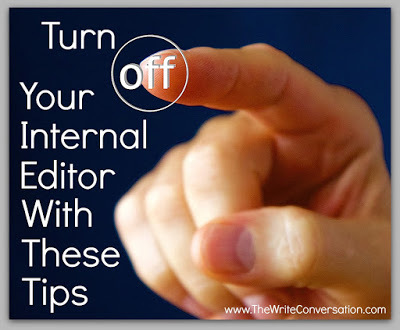Turn Off Your Internal Editor with These tips
by Edie Melson @EdieMelson
 In honor of NaNoWriMo, I'm going to share some insights I've gleaned about writing a first draft.
In honor of NaNoWriMo, I'm going to share some insights I've gleaned about writing a first draft.I’ve spoken with a lot of writers who have trouble disconnecting their INTERNAL EDITOR when they're working on an early draft of a manuscript.
This overly helpful person lives inside most of us and comes in handy when we’re putting the finishing touches on our manuscript. But when we’re in the midst of a creative surge, that same person can short circuit our progress.
Today's post will give you the tips you need to turn off your internal editor.
First you should know there’s a scientific reason for that roadblock. The creative act of writing your first draft stems from the right side—or creative side—of the brain. Later in the process, when polishing begins, the left side takes over. Here are some of the characteristics of each side.
Right Brain
 Visual in process, focusing more on patterns and images.Generally intuitive, led by feelings.Is the epitome of multi-tasking, able to process ideas simultaneously.Progresses from the big picture to the details.Lacks organization, utilizes free association.Left Brain
Visual in process, focusing more on patterns and images.Generally intuitive, led by feelings.Is the epitome of multi-tasking, able to process ideas simultaneously.Progresses from the big picture to the details.Lacks organization, utilizes free association.Left BrainMore verbal, needs to find specific words to express ideas.Analytical, led by logic.Takes things step by step, one idea at a time.Organizes details first before moving to the big picture.Very organized, utilizing lists and detailed plans.Mixing up the process—trying to use both sides of the brain at the same time—can lead to a tangled mess and a major roadblock. All of this information is good to know, but what if our left-brained, Internal Editor won’t go away? How do we make her be quiet? Unfortunately, there isn’t one way that works for everyone, but here are some tips that should help.
 Tips1. Don’t give in to temptation. Our Internal Editor gets stronger the more frequently we give in to her demands. If she thinks you need a certain word before you can finish that sentence, stay strong. Type XXX and go on. Later, during the rewriting process, you’ll have plenty of time to find the right word. This goes for anything that demands you slow the creative process. At this point in your manuscript speed is your best friend.
Tips1. Don’t give in to temptation. Our Internal Editor gets stronger the more frequently we give in to her demands. If she thinks you need a certain word before you can finish that sentence, stay strong. Type XXX and go on. Later, during the rewriting process, you’ll have plenty of time to find the right word. This goes for anything that demands you slow the creative process. At this point in your manuscript speed is your best friend.2. Set a daily and weekly word count goal. This can often sidetrack the Internal Editor because of her need to meet a goal. Sometimes, in her drive to succeed she can even become an ally.
3. Make lists in a separate notebook. Use your computer for the story, but if the need for details overshadows the creative urge, make a quick note in a notebook. Don’t let yourself get bogged down, but let the free association part of your right brain give you ideas to explore later with your more logical left side.
4. Don’t give in to fear. Many times our Internal Editor is driven by fear. Fear that this draft isn’t good, won’t work or just doesn’t make sense. Remind yourself that this version isn’t written in stone. Sometimes just giving ourselves permission to write what Anne Lamott calls the sh*%&# first draft is all we need to derail our Internal Editor.
All of these can help, but I’d like to know what tricks you use to keep that INNER EDITOR quiet.
Don't forget to join the conversation!Blessings,Edie
TWEETABLES
Turn off Your Internal Editor When You #Write Your First Draft - @EdieMelson (Click to Tweet)
To Win at #NaNoWriMo Use These Tips to Turn Off Your Internal Editor - @EdieMelson (Click to Tweet)
Published on November 03, 2015 01:00
No comments have been added yet.



